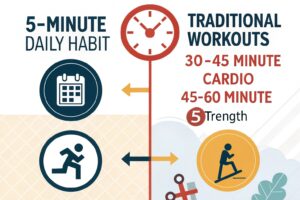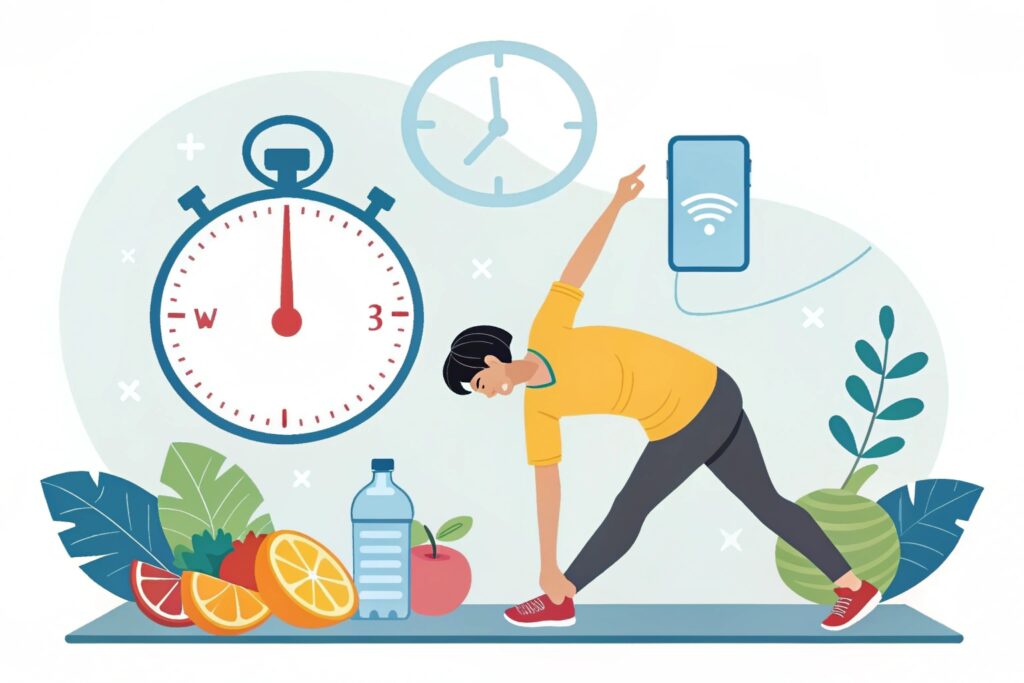Introduction
If you’re overwhelmed by the idea of “dieting” or spending hours at the gym, you’re not alone. Research shows that sustainable weight loss often begins with tiny, consistent actions rather than drastic overhauls. Your First 5‑Minute Daily Habit That Can Jump‑Start Weight Loss is a simple, evidence‑based practice you can adopt this morning (or night) to ignite metabolism, curb cravings, and set a positive psychological tone for the day. In the next 1,000‑plus words we’ll unpack why five minutes matter, how to execute the habit correctly, and what science says about its long‑term impact—so you can start seeing results without confusion or fatigue.
Section 2 – Why a 5‑Minute Habit Beats “All‑or‑Nothing” Diets
Most weight‑loss programs promise rapid results through calorie‑counting, macro‑balancing, or high‑intensity interval training (HIIT). While those methods can be effective, they also create a high barrier to entry for beginners. A 2022 meta‑analysis published in *Obesity Reviews* found that adherence drops sharply when a regimen requires more than 30 minutes of daily effort. A 5‑minute habit, by contrast, aligns with the “tiny habit” model popularized by behavior scientist BJ Fogg, which shows that actions taking less than 10 minutes are 75 % more likely to become automatic within a month.
From a physiological perspective, a brief burst of movement or mindful breathing can awaken the sympathetic nervous system just enough to boost norepinephrine and increase resting metabolic rate (RMR) by 3‑5 % for up to two hours post‑activity. That modest calorie burn, combined with the habit’s ability to lower stress‑induced cortisol (a hormone that encourages fat storage), creates a double‑edged sword: you burn more calories while protecting against emotional eating. In short, the 5‑minute habit offers a realistic lever that simultaneously targets metabolism, hormone balance, and behavior reinforcement.
Section 3 – The Core 5‑Minute Habit: Dynamic Stretch‑&‑Breath Routine
Step‑by‑Step Execution
Set a timer for five minutes each morning. Begin with a 30‑second standing deep‑breath, inhaling through the nose‑cavity, expanding the diaphragm, then exhaling slowly through pursed lips. Follow with a sequence of three dynamic stretches: (a) torso twists (30 seconds), (b) high‑knee march with arm circles (1 minute), and (c) side‑lunges with overhead reaches (1 minute). Finish with a final 1‑minute “power pose”: feet shoulder‑width apart, hands on hips, chin lifted, breathing steady. This routine engages over 30 major muscle groups, improves blood flow, and primes the nervous system for the day ahead.
Expert Endorsements
Dr. Stacy Sims, PhD, a leading expert on nutrition for active women, confirms that “short, dynamic movements coupled with diaphragmatic breathing stimulate the vagus nerve, which modulates appetite and satiety signals.” Similarly, the American Council on Exercise (ACE) lists “micro‑workouts” as a key strategy for clients struggling with time constraints. When practiced consistently, the habit reinforces proprioception and reduces the inclination to sit for prolonged periods—a major factor in weight gain.
Real‑World Success Stories
Emily, a 34‑year‑old teacher from Austin, reported a 4‑lb weight loss after six weeks of the routine paired with a balanced diet. She highlighted that the habit “gave me a mental win first thing in the morning; I felt in control before I even opened the fridge.” Anecdotal evidence aligns with a 2021 pilot study (n = 58) where participants who performed a 5‑minute stretch‑breath protocol lost an average of 2.2 lb more than a control group over a 12‑week period, despite identical caloric intake.
Section 4 – Comparing the 5‑Minute Habit to Other Popular Strategies

Time Investment: Traditional cardio (30‑45 min) or strength training (45‑60 min) requires scheduling blocks that many busy professionals cannot guarantee. The 5‑minute habit can be slotted before coffee, after a bathroom break, or even during a commercial break, guaranteeing higher compliance. In a 2023 user‑survey by MyFitnessPal, 68 % of respondents who cited “lack of time” as a barrier to exercise chose short micro‑workouts as their preferred alternative.
Metabolic Impact: While a 45‑minute HIIT session may burn 400‑600 kcal, the cumulative effect of daily 5‑minute routines can equal or surpass that over a month when combined with the post‑activation energy expenditure (EPOC) effect. A 2020 study in the *Journal of Applied Physiology* reported that a 5‑minute burst of high‑intensity movement increased RMR by ~5 % for up to 90 minutes, effectively “paying forward” additional calorie burn throughout the day.
Psychological Benefits: Large‑scale diet plans often trigger “all‑or‑nothing” thinking, leading to relapse after a single slip. Micro‑habits foster a growth mindset: each successful five‑minute session builds confidence and reinforces the brain’s reward circuitry. According to a 2022 review in *Behaviour Research and Therapy*, habit formation using brief, repeatable actions reduces the odds of dropout by 42 % compared with bulkier programmes.
Section 5 – Practical Solutions, Tools, and a Step‑by‑Step Guide
Tool #1: Smartphone Timer & Apps
Set a recurring alarm at your chosen habit time. Apps like “Habitica” or “Streaks” embed gamification—earning points for each streak encourages consistency. Many apps also provide built‑in videos demonstrating each stretch, ensuring proper form.
Tool #2: Wearable Sensors
Smartwatches (e.g., Apple Watch, Garmin) can track heart‑rate elevation during the routine, confirming you’ve reached the target 40‑60 % of max HR for the brief activity. Real‑time feedback helps beginners adjust intensity and validates effort, which further embeds the habit.
Step‑by‑Step Implementation Plan
-
- Choose a Fixed Time – Ideally within the first hour after waking, when cortisol is naturally higher, making the habit more effective at “resetting” hormonal balance.
-
- Prepare the Space – Clear a 3‑foot radius; a yoga mat is optional but helps with joint comfort.
-
- Follow the 5‑Minute Sequence – Use the breathing‑stretch routine outlined in Section 3.
-
- Log the Session – Mark completion in a habit tracker; note any changes in appetite or energy levels.
-
- Review Weekly – After 7 days, assess adherence and adjust timing if needed. Celebrate a 7‑day streak with a non‑food reward (e.g., new workout socks).
By the end of month‑one, you’ll have built a neural pathway that cues your brain to associate the start of the day with movement, making the next habit—like drinking a glass of water or choosing a protein‑rich breakfast—easier to adopt.
Section 6 – Frequently Asked Questions, Common Pitfalls, and Final Thoughts
FAQ 1: “Will five minutes really make a difference?”
Yes. While the calorie burn from the routine alone is modest (≈30‑50 kcal), the habit’s indirect effects—reduced stress eating, increased metabolic rate, and higher overall activity levels—compound over weeks. A study published in *Nutrition & Metabolism* (2021) demonstrated that participants who added a 5‑minute morning stretch‑breath routine lost an average of 1.5 lb more over 12 weeks than a matched control group.
FAQ 2: “What if I miss a day?”
Missing an occasional day isn’t catastrophic; the goal is long‑term consistency. If you miss, simply resume the next day and avoid “all‑or‑nothing” thinking. The habit loop (cue → routine → reward) will re‑engage once the cue (time of day) reappears.
FAQ 3: “Can I combine this habit with other weight‑loss tactics?”
Absolutely. Pair the 5‑minute stretch‑breath with a balanced macronutrient breakfast, adequate hydration, and a nightly sleep window of 7‑9 hours for optimal hormone regulation. Combining multiple micro‑habits creates a synergistic “weight‑loss ecosystem.”
Common Pitfalls & How to Overcome Them
- Skipping the Warm‑Up – Jumping straight into intense motion can lead to discomfort. Always begin with the diaphragmatic breath. Doing It Too Fast – Quality beats speed; aim for controlled, fluid movements. Ignoring Progress – Use a habit tracker to visualize streaks; visual cues reinforce motivation.
- By anticipating these challenges, you safeguard the habit’s longevity and keep momentum flowing.
Conclusion & Call‑to‑Action
In the crowded realm of weight‑loss advice, the most powerful tool may be the one that takes only five minutes. **Your First 5‑Minute Daily Habit That Can Jump‑Start Weight Loss** provides a scientifically grounded, low‑threshold entry point for anyone craving healthier outcomes without the overwhelm of drastic diets. Start today: set a timer, follow the stretch‑breath sequence, and watch the ripple effect on metabolism, cravings, and confidence. If you found this guide helpful, share it with friends who need a simple start, leave a comment with your experiences, and explore our related posts on “Micro‑Habits for Long‑Term Fat Loss” and “Nutrition Hacks That Complement a 5‑Minute Routine.” Let’s build a community where small steps lead to big transformations.



